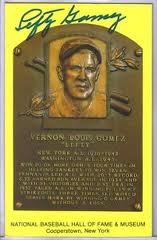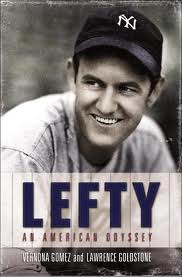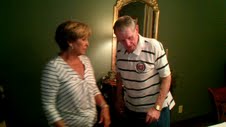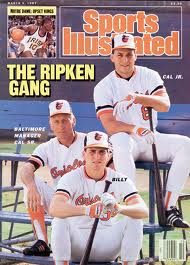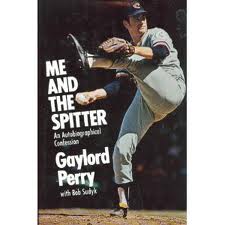 |
Want a unique copy of
this Hall of Famer’s book?
To quote from Bobby’s
sale catalog:
SIGNED by Gaylord Perry & INSCRIBED
to the catcher Alan Ashby
as follows: “It’s great to have you with us.
You will have many great years to come.
The best to you and your family.”
Ashby came up with the Indians
in 1973 & played parts of 4 seasons
with them – all as Perry’s teammate. – 85.00 |
Baseball books have a best friend. His name is Bobby Plapinger.
Many know about good baseball titles. Bobby knows what makes a memorable autographed baseball book. I’m grateful that he shares his knowledge and experience with us in this e-interview.
Q: Any tips for getting baseball books autographed (pen to use? Get title page signed?) Who knows? Readers may be contacting you with their recently-signed books to buy?
A: This is really a matter of personal preference. Mine is to have the signer use an ink pen – black or blue – & sign the front flyleaf – the 1st blank page, or the title page.
If it’s someone I know – or have met – I just tell them to do it however they want to.
I like ink better than sharpie because it just seems clearer to me – also, the pen tends to make very fine indentations into the paper, which can help for future identification purposes.
Some people like “personalizations” others don’t. I tend to prefer a “straight signature” unless the signer is an aquaintance of some kind – but I don’t make a big stink about this either. If someone wants to write “To Bobby…” or the like, I don’t protest.
And… of course a personalized signature is less likely to be forged & thus can be good proof of authenticity if & when that’s required.
The one thing I think you should AVOID at all costs, is having the dust jacket or cover, of the book signed. While it can be easy to display, they’re subject to damage from moisture, light or worse & can easily smear, smudge and/or fade. And “protecting” a dj with a signature on it – something you should do, as described above, can actually damage the signature on a signed dj. I’ve seen the ink from a sharpie or marker signature, transfer from the dj to the mylar cover – that fades & smears the original signature.
I’m always open making offers on books. Just remember, just like the guys on “Pawn Stars” (& it’s brethren & spawn…) I’m buying for resale – so chances of my paying a premium on a recently signed book are pretty small.
It’s kind of ironic – but you can buy signed books from most of the Hall of Famers who are doing shows these days for far less than an autograph ticket to have the guy sign the book at a show.
You’d like to think you could sell your signed Hank Aaron autobiography for more than the $200 – $300 you just paid to have him sign it…
You’d be hard pressed to do so.
And that means MY offer will be even less…. ALOT less….
Look at the prices in the signed book list. Figure I’d pay you approx 10%-30% of my asking price for your books, IF, I want them.
Q: Collectors get phobic about collectibles, wanting everything under glass or in plastic. DO YOU TOUCH THE ACTUAL SIGNED BOOK, one gasps?!?
Tips about displaying/preserving/enjoying an autographed book?
A: Again – this is a matter of preference. Books are remarkably hardy if you keep them dry, away from direct sunlight & relatively clean.
You want to store them on shelves. “Standing up”. You want to avoid long term storage of “stacks” of books lying on their “backs” – can lead to dj wear & tear, bumps & bruises & the like.
If you have large oversize books you can “stack” them – as long as they’re protected – on a shelf – NOT the ground.
If the shelves provide cover from dirt/dust – all the better. Use a feather or “swiffer” for dusting, cleaning.
I like to use mylar dust jacket covers – often called “Brodarts” (for the primary manufacturer – although there are a number of different brands) to protect jackets. They help defend against dust, moisture & for older jackets, prevent further deterioration of jackets that already have some age wear.
You can get “acid free museum quality” dj covers if you’re really anal – but the “standard” issue should suffice for all but the most particular.
I think the whole point of books is that they should be read. So – yes – I touch my books. But… carefully – you don’t need to wear white gloves – but you might want to make sure your hands aren’t dirty and/or sticky. Teach kids to treat books carefully, and/or keep yours away from those who are still learning.
You can, if you like, put all/some of your books in mylar bags & for some that are old and/or rare and/or fragile, this might be a good idea. But in general I think books “breathe” the environment around them & enjoy doing so – and an occasional dusting/cleaning – is more than sufficient for preserving most books in most environments.
I like to think that I treat my books – both the ones in my “personal collection” and the ones I sell – carefully and respectfully. But I once got into a big argument with a collector at a show – I write my book prices – in pencil, lightly – in the upper right corner of the front flyleaf (or 1st white page) – & this guy was outraged that I would even consider writing in such a valuable artifact. Even when I explained – demonstrated in fact – that the “writing” was easily removable & then indetectable – he insisted I was wrong to mar the books in that way.
So… as I say… It’s a matter of personal preference.
I like the look of books on a bookshelf. A whole array of “spines out” – really appeals to me. To break up the monotony I use “tchackes” – little figures, pennants, puppets, pictures etc.etc. etc. I also like to display a few favorite books “face out” – with the cover facing the room.
This takes up a little more space, but looks really nice. I think. Then again – I’m used to a bookstore where you use “face out” to entice customers to buy stuff. But I think the principle is the same.
Plus, you can, if you like, change the books you “face out” – which can really change the “look” of your room.. well…. your shelf at least.
Q: What’s your feeling about autographed bookplates?
A: I think part of the appeal of signed books is the notion that the signer actually touched – however briefly & minimally – the book.
You lose that with a bookplate. Also – bookplates lend themselves to fraud – as it’s alot easier to “practice” signatures on cheap inexpensive bookplates that take up no space, than on a pile of books.
That said – many publishers of “signed limited editions” have the signers autograph blank sheets of paper which are later bound into the books. So in those cases, the signer never touches the book & the buyer never knows the wiser..
Well… you do now.
Jerome Holtzman once told me he had “stacks” of sheets of paper signed by Bill Veeck sitting in his basement waiting for a future printing of the “Holtzman Press” “signed, leatherbound edition” of “Veeck As In Wreck” which never materialized.
In spite of my general dislike for signed bookplates, I guess there could be exceptions – if you have custom bookplates & every “signed book” has one in them, that could be kind of cool. I always thought it would be neat to mount signed baseball cards of a player inside his biography/autobiography. In the days of common “by mail” signings, it was a lot easier and cheaper to send cards through the mail than books – not to mention the risk of potential damage in shipping to the book.
I never followed through on this plan – but I still think a library full of “signed” books w. the signatures on attractive bb cards – would be a pretty neat one.
Q: Tell the readers how to get your autographed baseball book sales list by e-mail.
Send me an e-mail at baseballbooks@opendoor.com
and I’ll send you the list. I generally just “paste” it in to the e-mail. If you’re mailing from work, make sure to add that address to your “address book” or else it will just get bounced back to me because corporations hate little, local ISP like “OpenDoor.com” .
I can also attach a PDF of the Spring/Summer Baseball Catalog which lists the majority of my current inventory.
I welcome questions and/or comments about signed books – or anything else you think I can help with. I don’t “social network” but I always answer e-mails & occasionally speak on the phone.
Coming Monday: A troubling headline for autograph collectors
Like this:
Like Loading...
